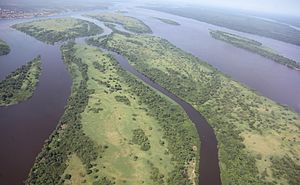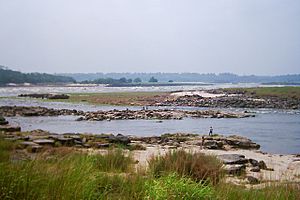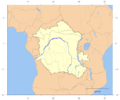Congo River facts for kids
Quick facts for kids Congo River |
|
|---|---|

The Congo River near Kisangani, Congo
|
|

The drainage basin of the Congo River
|
|
| Other name(s) | Zaire River |
| Physical characteristics | |
| Main source | Lualaba River Boyoma Falls 1,590 m (5,220 ft) |
| River mouth | Atlantic Ocean 06°04′27″S 12°26′59.99″E / 6.07417°S 12.4499972°E |
| Length | 4,700 km (2,900 mi) |
| Width |
|
| Depth |
|
| Basin features | |
| Basin size | 4,014,500 km2 (1,550,000 sq mi) |
| Tributaries | |
The Congo River (Kongo: Nzâdi Kôngo, French: Fleuve Congo, Portuguese: Rio Congo), formerly also known as the Zaire River, is the second longest river in Africa, shorter only than the Nile, as well as the second largest river in the world by discharge volume, following only the Amazon. It is also the world's deepest recorded river, with measured depths around 219.5 m (720 ft). The Congo-Lualaba-Chambeshi River system has an overall length of 4,700 km (2,920 mi), which makes it the world's ninth-longest river. The Chambeshi is a tributary of the Lualaba River, and Lualaba is the name of the Congo River upstream of Boyoma Falls, extending for 1,800 km (1,120 mi).
Measured along with the Lualaba, the main tributary, the Congo River has a total length of 4,370 km (2,715 mi). It is the only major river to cross the Equator twice. The Congo Basin has a total area of about 4,000,000 km2 (1,500,000 sq mi), or 13% of the entire African landmass.
The Congo gets its name from the old Kingdom of Kongo which was at the mouth of the river. The Democratic Republic of the Congo and the Republic of the Congo, both countries sitting along the river's banks, are named after it. From 1971 to 1997, the Democratic Republic of the Congo was called Zaire and its government called the river the Zaire River.
The sources of the Congo are in the Highlands and mountains of the East African Rift, as well as Lake Tanganyika and Lake Mweru, which feed the Lualaba River. This then becomes the Congo below Boyoma Falls. The Chambeshi River in Zambia is usually taken as the source of the Congo because of the accepted practice worldwide of using the longest tributary, as with the Nile River.
The Congo flows mostly west from Kisangani just below the falls, then slowly bends southwest, passing by Mbandaka, joining with the Ubangi River, and running into the Pool Malebo (Stanley Pool). Kinshasa (formerly Léopoldville) and Brazzaville are on opposite sides of the river at the Pool, where the river narrows and falls through a few cataracts in deep canyons (collectively known as the Livingstone Falls), running by Matadi and Boma, and into the sea at the small town of Muanda.
Contents
History of exploration
The mouth of the Congo was visited by Europeans in 1482, by the Portuguese Diogo Cão, and in 1817, by a British exploration under James Kingston Tuckey that went up the river as far as Isangila. Henry Morton Stanley was the first European to travel along the whole river.
Economic importance
Although the Livingstone Falls stop ships coming in from the sea, almost all of the Congo is navigable in parts, especially between Kinshasa and Kisangani. Railways cross the three major falls that interrupt navigation, and much of the trade of central Africa passes along the river. Goods include copper, palm oil, sugar, coffee, and cotton. The river can also be valuable for hydroelectric power, and Inga Dams below Pool Malebo have been built.
In February of 2005, South Africa's state owned power company, Eskom, said that they had a proposal to increase the amount of electric power that the Inga can make through improvements and the building of a new hydroelectric dam. The project would bring the highest output of the dam to 40 GW, twice that of China's Three Gorges Dam.
Natural history

The current course of the Congo River formed between 1.5 and 2 million years BP, during the Pleistocene. It is likely that during this period many upper tributaries of the Congo were captured from adjacent river basins, including the Uele and upper Ubangi from the Chari system and the Chambeshi River alongside a number of upper Kasai River tributaries from the Zambezi system.
The Congo's formation may have led to the allopatric speciation of the bonobo and the common chimpanzee from their most recent common ancestor. The bonobo is endemic to the humid forests in the region, as are other iconic species like the Allen's swamp monkey, dryas monkey, aquatic genet, okapi, and Congo peafowl.
In terms of aquatic life, the Congo River Basin has a very high species richness and among the highest known densities of endemics. As of 2009[update], almost 800 fish species have been recorded from the Congo River Basin (not counting Lake Tanganyika, which is connected but ecologically very different), and large sections remain virtually unstudied. For example, the section in Salonga National Park, which is about the size of Belgium, had still not been sampled at all in 2006. New fish species are scientifically described with some regularity from the Congo River Basin, and many undescribed species are known.
The Congo has by far the highest diversity of any African river system; in comparison, the next richest are the Niger, Volta and Nile with about 240, 140 and 130 fish species, respectively. Because of the great ecological differences between the regions in the Congo basin —including habitats such as river rapids, deep rivers, swamps, and lakes— it is often divided into multiple ecoregions (instead of treating it as a single ecoregion). Among these ecoregions, the Livingstone Falls cataracts has more than 300 fish species, including approximately 80 endemics while the southwestern part (Kasai River basin) has more than 200 fish species, of which about a quarter are endemic.
The dominant fish families – at least in parts of the river – are Cyprinidae (carp/cyprinids, such as Labeo simpsoni), Mormyridae (elephant fishes), Alestidae (African tetras), Mochokidae (squeaker catfishes), and Cichlidae (cichlids). Among the natives in the river is the huge, highly carnivorous giant tigerfish. Three of the more unusual endemics are the whitish (non-pigmented) and blind Lamprologus lethops, which is believed to live as deep as 160 metres (520 ft) below the surface, Heterochromis multidens, which is more closely related to cichlids of the Americas than other African cichlids, and Caecobarbus geertsii, the only known cavefish in Central Africa. There are also numerous endemic frogs and snails. Several hydroelectric dams are planned on the river, and these may lead to the extinction of many of the endemics.
Several species of turtles and the slender-snouted, Nile and dwarf crocodile are native to the Congo River Basin. African manatees inhabit the lower parts of the river.
Tributaries
Listed from down a river, to up a river:
- Inkisi
- Nzadi
- Nsele (south side of Pool Malebo)
- Bombo
- Kasai (between Fimi and Congo, known as Kwa)
- Fimi
- Lukenie
- Kwango
- Sankuru
- Likouala
- Sangha
- Ubangi
- Giri
- Uele
- Mbomou
- Luvua
- Luapula
Images for kids
See also
 In Spanish: Río Congo para niños
In Spanish: Río Congo para niños








